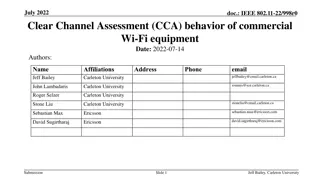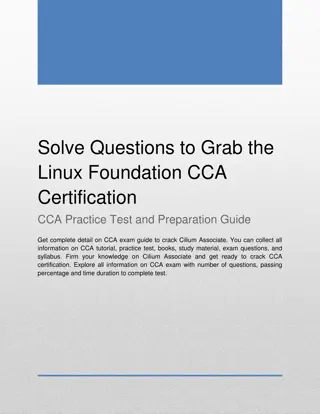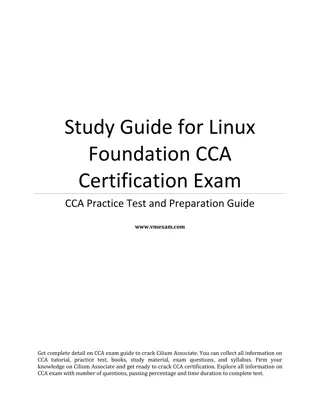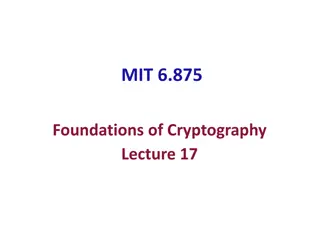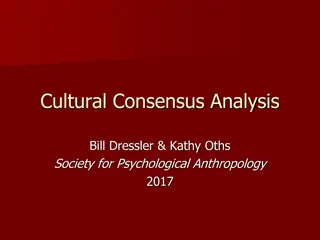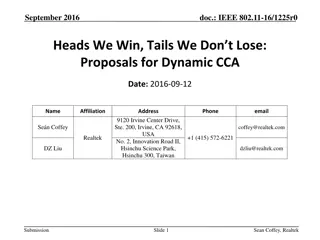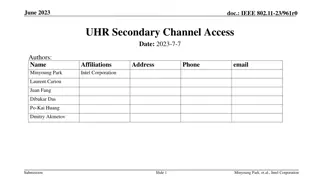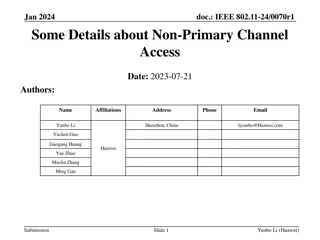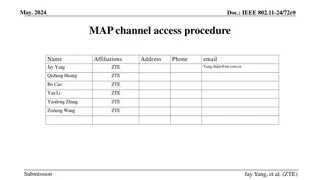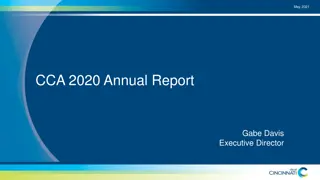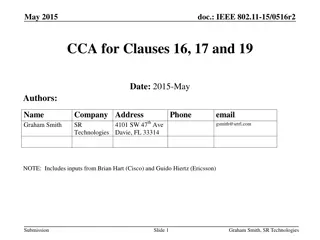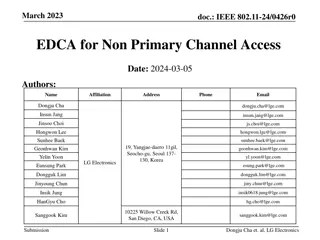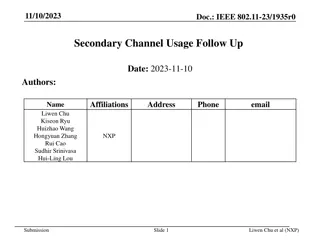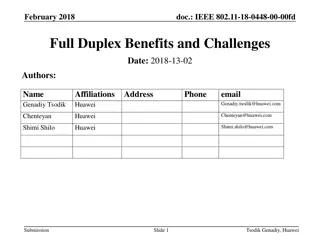ML CCA and Channel Access for non-STR Limks
Discussing ML CCA challenges in non-STR link pairs and proposing solutions. Describing issues in non-STR related operations and CCA blindness when transmitting signals.
Download Presentation

Please find below an Image/Link to download the presentation.
The content on the website is provided AS IS for your information and personal use only. It may not be sold, licensed, or shared on other websites without obtaining consent from the author.If you encounter any issues during the download, it is possible that the publisher has removed the file from their server.
You are allowed to download the files provided on this website for personal or commercial use, subject to the condition that they are used lawfully. All files are the property of their respective owners.
The content on the website is provided AS IS for your information and personal use only. It may not be sold, licensed, or shared on other websites without obtaining consent from the author.
E N D
Presentation Transcript
2020 doc.: IEEE 802.11-2020/1221 ML CCA and Channel Access for non-STR Links Date: 2020-08-13 Authors: Name Affiliation Address Phone Email Yonggang Fang ZTE (TX) yfang@ztetx.com Bo Sun ZTE Zhiqiang Han ZTE Liuming Lu ZTE Submission 1 Yonggang Fang, etc.., ZTE
2020 doc.: IEEE 802.11-2020/1221 Abstract This contribution discusses the ML CCA issue in a pair of non-STR links and proposes solutions to address this issue. Submission 2 Yonggang Fang, etc.., ZTE
2020 doc.: IEEE 802.11-2020/1221 Introduction ML Operation Scenario SFD [1] indicates the R1 shall support two cases: 1) STR AP MLD with STR non-AP MLD 2) STR AP MLD with non-STR non-AP MLD In this contribution, it will discuss the scenario 2) Submission 3 Yonggang Fang, etc.., ZTE
2020 doc.: IEEE 802.11-2020/1221 Issues of non-STR Related Operations Definitions STR or non-STR refers to a pair of links STR Channel Access [1]: 802.11be shall allow the following asynchronous multi- link channel access: Each of STAs belonging to a MLD performs a channel access over their links independently in order to transmit frames. Downlink and uplink frames can be transmitted simultaneously over the multiple links. Non-STR Operation: An MLD that is not capable of simultaneous Tx/Rx on multiple links for the given set of links (i.e., it can only do Tx/Tx or Rx/Rx on a pair of links) In [3], it discusses the operation of a pair of non-STR links in wide bandwidth. The non-STR link is possible to separate into three parts STR part STR constraint part Non-STR part Submission 4 Yonggang Fang, etc.., ZTE
2020 doc.: IEEE 802.11-2020/1221 Issues in a pair of non-STR Links ML Channel Access for A Pair of non-STR Links A pair of non-STR links does not support transmitting and receiving simultaneously. It may lead to the following constraints on the ML channel access: A. A MLD may have some constraints on CCA mechanism on a non-STR link when it is transmitting PPDU(s) on another non-STR link. B. A MLD should not transmit a PPDU on an idle non-STR link when it is receiving PPDU(s) on another non-STR link. RSSI at RSSI at receiving antenna receiving antenna Signal from other STA Signal from other STA EDT Self- Interference PDT Rx sensitivity Rx sensitivity ML CCA Baseline CCA with self-interference Submission 5 Yonggang Fang, etc., ZTE
2020 doc.: IEEE 802.11-2020/1221 Issues in a pair of non-STR Links CCA Blindness When a MLD transmits a frame on a non-STR link, the transmitting signal from that link may leak out to interfere to the other non-STR link in listening mode: The CCA in other non-STR link would not be able to detect the preamble or the signal energy from other STAs if the cross link interference is strong enough If the other non-STR link is in the EDCA backoff, the backoff procedure would be suspended by the cross link interference. Interference causes CCA blind Link 2 Non-STR non-AP MLD interference from link 1 Time Link 1 Transmit UL PPDU Interfere to CCA of other link Submission 6 Yonggang Fang, etc., ZTE
2020 doc.: IEEE 802.11-2020/1221 Issues in a pair of non-STR Links Reception Interruption Case 1: If one non-STR link is in the receiving mode already, another non-STR is going to start CCA and transmit a PPDU. The cross-link interference from the non- STR transmitting link would interrupt the reception on the non-STR receiving link. Case 2: This is a race condition. When one non-STR link is receiving a preamble, but another non-STR link is in EDCA backoff procedure. If the EDCA backoff reaches to 0 and starts to transmit, the cross-link interference from the non-STR transmitting link may interrupt the reception on the non-STR receiving link. Cause reception interrupted Cause reception interrupted Receiving a PPDU Receiving a PPDU Preamble Preamble Link 2 Link 2 Non-STR non-AP MLD Non-STR non-AP MLD interference from link 1 interference from link 1 Time Time Link 1 Link 1 OBSS Transmit UL PPDU Transmit UL PPDU Interfere to reception of other link (1) Interfere to reception of other link (2) Submission 7 Yonggang Fang, etc., ZTE
2020 doc.: IEEE 802.11-2020/1221 A Proposal of Channel Access Baseline Channel Access Physical CCA Carrier Sensing is used to assess the channel occupancy state CCA Preamble Detection: If the CCA detects a preamble of a frame and its signal strength is less than PDT (-82dBm), the channel is assessed as idle. Otherwise, the channel is busy. The PD can be used to set NAV. CCA Energy Detection: If the CCA detects a signal other than the preamble and its signal strength is less than EDT (-62dBm), the channel is assessed as idle. Otherwise, the channel is busy. The ED has to detect the signal in every time slot to determine whether the signal exists or not time. It may not be used to set NAV. Submission 8 Yonggang Fang, etc., ZTE
2020 doc.: IEEE 802.11-2020/1221 A Proposal of Channel Access Constraint Period Tx Constraint Period is the time period that a frame is being transmitted on a non-STR link and interferes to another non-STR non-transmitting link. ML CCA Rules in Tx Constraint Period (1) Option 1: The MLD should set CCA state to Busy on the non-STR non-transmitting link during Tx Constraint period. Note: During the Tx Constraint period, the cross-link interference from the non-STR transmitting link would interfere CCA measurement accuracy on the non-STR non-transmitting link. Set CCA state = Busy Transmits a PPDU CH Busy (OBSS) Link 2 Non-STR MLD Link 1 Transmit UL PPDU Time Tx Constraint Period Submission 9 Yonggang Fang, etc., ZTE
2020 doc.: IEEE 802.11-2020/1221 A Proposal of Channel Access ML CCA Rules in Tx Constraint Period (2) Option 2: An affiliated STA of MLD may perform ML CCA on a non-STR non- transmitting link during the Tx Constraint Period using the adjusted CCA measurement method with ED threshold. The adjusted CCA measurement is the measured signal strength on a link minus the interference on that link from the non-STR transmitting link (e.g. link1) in the Tx Constraint Period. If the adjusted CCA measurement < ED threshold, the channel is assessed as idle and the affiliated STA starts the EDCA backoff procedure (e.g. on link2). The adjusted CCA provides flexibility for asynchronous transmission over a pair of non-STR links. Perform the adjusted ML CCA Transmits a UL PPDU CH Busy (OBSS) Link 2 Non-STR MLD Link 1 Transmit a UL PPDU Time Tx Constraint Period Submission 10 Yonggang Fang, etc., ZTE
2020 doc.: IEEE 802.11-2020/1221 A Proposal of Channel Access Constraint Period Rx Constraint Period is the time period that the frame addressed to the MLD is being received on a non-STR link and the reception will be interrupted if the MLD starts to transmit on another non-STR link. ML CCA Rules in Rx Constraint Period MLD may notify Rx Constraint Period to its STA on the non-STR non receiving link. During the Rx Constraint Period, the affiliated STA of the MLD may holds the backoff counter at 0 and the channel access on the non-STR non-receiving link. Note 1: This is to address the case (1) of reception interruption. Note 2: The non-STR links may need to synchronize the transmissions after the Rx Constraint period. Hold the BC at 0 and channel access Transmit a UL PPDU CH Busy (OBSS) Link 2 Non-STR MLD Link 1 Transmit a UL PPDU Receiving a DL PPDU Time Rx Constraint Period Submission 11 Yonggang Fang, etc., ZTE
2020 doc.: IEEE 802.11-2020/1221 Summary This contribution Discuss the issue of cross-link interference to CCA in the non-STR links Suggest in the Tx constraint period to restrict the CCA or use adjusted CCA for the channel assessment to compensate cross-link interference from the non-STR transmitting link. Suggest in the Rx constraint period to hold the backoff counter at 0 and channel access on the non-STR non-receiving link. Submission 12 Yonggang Fang, etc., ZTE
2020 doc.: IEEE 802.11-2020/1221 Straw Poll (1) Do you support to include the following in SFD ? During the Tx Constraint period, a MLD should set the CCA state to busy on a non-STR non-transmitting link. Note: Tx Constraint Period is the time period that a frame is being transmitted on a non-STR link and interferes to another non-STR non-transmitting link. YES/NO/ABS Submission 13 Yonggang Fang, etc., ZTE
2020 doc.: IEEE 802.11-2020/1221 Straw Poll (2) Do you support to include the following in SFD ? During the Tx Constraint period, a MLD may perform the adjusted ML CCA on a non-STR non-transmitting link. Note: Tx Constraint Period is the time period that a frame is being transmitted on a non-STR link and interferes to another non-STR non-transmitting link. YES/NO/ABS Submission 14 Yonggang Fang, etc., ZTE
2020 doc.: IEEE 802.11-2020/1221 Straw Poll (3) Do you support to include the following in SFD ? During Rx Constraint Period, a MLD may perform ML CCA sensing on a non-STR non-receiving link, and EDCA backoff procedure if the ML CCA senses the link idle. The MLD should hold the backoff counter after reaching at 0 and the channel access on the non-STR non receiving link. Note: Rx Constraint Period is the time period that the frame addressed to the MLD is being received on a non-STR link of the MLD. YES/NO/ABS Submission 15 Yonggang Fang, etc., ZTE
2020 doc.: IEEE 802.11-2020/1221 References [1] 11-20-0566-53-00be-compendium-of-straw-polls-and-potential-changes-to- the-specification-framework-document [2] 11-20-0026-02-00be-mlo-sync-ppdus [3] 11-20-1220-00-00be-STR and non-STR capability indication [4] 11-20-0069-05-00be-multi-link-communication-mode-definition Submission 16 Yonggang Fang, etc., ZTE
2020 doc.: IEEE 802.11-2020/1221 Thank you! Submission 17 Yonggang Fang, etc., ZTE












